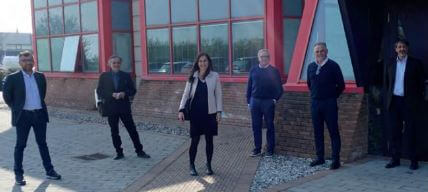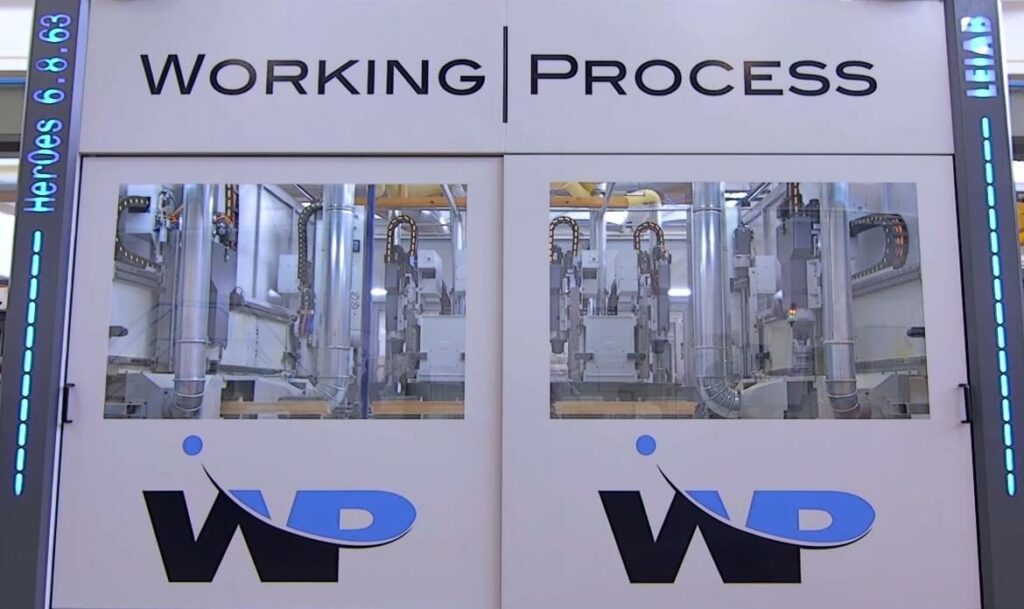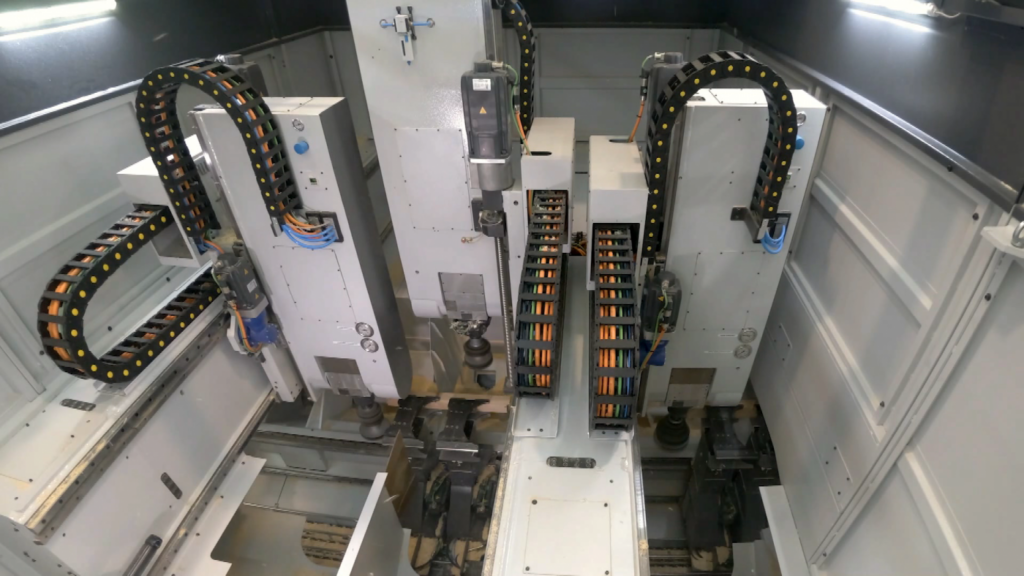We had the opportunity to meet Alessandro Merlino, sales manager Italy, and Luciano Corbetta,sales and marketing director, of Brevetti Stendalto and the owner and the management of WorkingProcess, Stefano and Filippo Schegginetti and Paolo Perservati: for the authors of this article, SoniaMaritan and Pietro Ferrari, it was an opportunity for a valuable teaching exercise that we want toshare with our readers.
The chain boutique – A fundamental and far from insignificant component in the construction of amachine, but also in an infinite number of unthinkable applications is the energy chain, in this sectorBrevetti Stendalto which we will have the opportunity to talk about in an upcoming issue ofIndustry del Mobile is a point of reference in the sector, but we give the floor to Alessandro Merlinowho briefly tells us the story and describes the characteristics of what is defined as “the boutique of the chain”.
From the left Alessandro Merlino, Pietro Ferrari, Sonia Maritan, Stefano Schegginetti, Paolo Perservati e Luciano Corbetta
Alessandro Merlino – Brevetti Stendalto is a 100% Italian company, made in Italy, I would say “made in Brianza”, born in 1968 from an intuition of Giovanni Mauri, still present in the company in product research and development, history is typical of those years: it begins with the activity of a historic company in Monza, San Rocco, a manufacturer of lathes. Steel chains were used on these lathes, because only those existed, but the idea was soon to have these chains molded in nylon, witha patented mold. The molding of these nylon chains was the work of a company, also from Monza,which made clothes airers, with that Stendalto brand (linked to its previous production) that remains today.
In 1976 the history of the company Brevetti Stendalto begins, based in Monza, where the semi-finished components made in the Mesero production unit are assembled, a reality that operates 24hours a day on three shifts. Today, in the company, there is the second generation made up ofGiovanni’s children, Claudio and Laura, who govern the joint-stock company in which the presenceof the family is majority. The nylon chain was therefore born from Brevetti Stendalto and hasspread all over the world to the point that even today the Made in Italy Stendalto chains arrive inthe Chinese branch, preferred by the companies of the Asian giant level.
Luciano Corbetta – We can add that the internationalization of Brevetti Standalto began with thesecond generation of the family at the beginning of the 2000s and that today, Brevetti Stendaltohas six branches, in France, Germany, Norway, the United States, in China and Australia. These are commercial branches which, however, in the United States and China, have the possibility of assembling the product, less possibilities to carry out operations of this type also exist in the other branches. We think that today there are about 5500 product codes, which can be customized oncustomer request. So very often we start from the basic components and assemble the finishedcomponent. Brevetti Stendalto is a very verticalized company: we ourselves are the producers ofour basic components and carry out the basic processing of the chains and the making of the molds. It is Filippo Schegginetti who tells us about the beginning of the collaboration between WorkingProcess, a technological leader in window and door machines but also increasingly present in the furniture sector.
Filippo Schegginetti – Our collaboration with Brevetti Stendalto started in a challenging situation in which, as soon as we asked the sales manager to do something more to further improve theperformance of the product used in Working Process, we immediately received a visit from atechnical manager as well as the sales representative who allowed us, with an appropriate upgrading, to bring our machines to a higher level. So from a consultative point of view it was notand is not just a relationship between the company that sells and the customer who buys, but wealso move towards finding solutions that go hand in hand with the evolution we are experiencing.
This is fundamental, because finding a static and firm company on the other side, especially not ableto follow and propose alternative and innovative solutions to the problems that can been countered in everyday life, is disappointing, just as the exact opposite is important: The machine is standard, the component is standard even within its specialization: it is nice to talk about standardization when, however, it is also possible to make highly customized products that are part of a standard production within the production processes. At the same time, the union of many standard elements that make up a tailor made or sartorial ensemble, if you prefer, emphasizes something fundamental which is the analysis, from time to time, of a “unicum standard”.
Alessandro Merlino – In fact, over time we have often found ourselves busy finding the right compromise between the standardized product and the one conceived ad hoc for a single creation, following step by step the working process speed on different product ranges.
Sonia Maritan – So for you, did collaborating with this technological leader also lead to the creation of specific chains that were not in the catalog?
Alessandro Merlino – We start from a base that is a standard chain but to the latter we add adevice, for example, against dust or shavings where there are high quantities of material removed, or we find very high speeds with very high chains. long that must be designed to with stand these characteristics. For example, this required frequent visits from our technical office and we must also underline the willingness of the Working Process technicians to carry out tests with us.
Paolo Perservati – Working Process, for some years has been building with a philosophy that for usis a brand, so much so that it is a trademark registered as TWC (Technology Without Compromise), a very precise, strategic, defined choice, desired by the whole of all the partners to go and buildmachines without any compromise, placing themselves in a high-end market not only in terms of price but also in the realization of the perception by the potential customer of being in a context that goes beyond normal solutions. Obviously, in order for us to propose such a goal, suppliers mustbe an integral part of the idea.
Probably Working Process could have chosen standard chains from another supplier with cheaper solutions but would have had to accept compromises and this would not have been in accordance with our guideline and our philosophy.
For this reason, for us, suppliers are increasingly an integral part of the company, they are strategicin design, commercial and construction choices, and this is certainly one of the reasons for the collaboration with Brevetti Stendalto. In this case, if we want to go at certain speeds or on certain lengths of the energy chain, we know who to contact. It is therefore important that those whoshare this project have a similar philosophy.
Stefano Schegginetti – What must be taken into consideration for the future is that this “valuechain”, because this is what it is, is made up of many margins: every company must have its own margin and must take advantage of the value chain itself. If any company fails to maintain margins with adequate and competitive prices, it destroys the value chain, because I am unable to sustainably buy a component, however excellent at values, that destroys my entry price in themarket. So the path that we are following as manufacturers of machines that must have different components is to retain different suppliers that allow us to obtain a product of the highest level atthe right price.
The secret of the Italian victory over the rest of the world lies in the fact that the entrepreneurs ofour country have understood that they must themselves, depending on their specialization, be able to commit themselves as much as possible to ensure that a small but fundamental component of machine or any other tool, gives rise, after bringing the right profit, to a finished product that is comparable in a correct and competitive manner within the market, otherwise we destroy the valuechain. This value chain becomes a plus for our customer, a surplus that allows them to produce at a high quality level with a fair market price in the technological investment.
A technological challenge

Sonia Maritan – What was the technological challenge you faced with Working Process?
Luciano Corbetta – The challenge was to find ourselves overnight rethinking the relationship with the customer, a customer who challenged everything in terms of racing and speed.
Filippo Schegginetti – In practice it is as if the technical office of Brevetti Standalto had moved tous to tackle a problem of this type.
Luciano Corbetta – We have gone beyond the customer-supplier relationship, in accordance withour current philosophy of proposing ourselves not as manufacturers of energy chains but assolution providers.
Filippo Schegginetti – This very conveniently, because by now the perspective has changed drastically: the supplier-customer relationship is no longer the paradigm of ten years ago but noteven five years ago. Either you manage to do a technical, mechanical or software partnership path together or you can’t grow together.
Sonia Maritan – We are talking about an important partner, because among the components ofyour machines this has a significant importance…
Paolo Perservati – In our design evolution we are thinking of some path, such as that of carryingout a greater number of pre-assemblies, which allows us to produce more quickly.
Luciano Corbetta – For us, working on orders is becoming a standard: a product line like the Total Chain.
Paolo Perservati – We want to do an exercise on an entry level machine that goes in this direction, the results of this exercise will be transferred to the other machines, so that we can greatly compress construction times, but not only: we want to work not only on construction times but alsoon installation times, that is, assembly and disassembly in the factory and assembly at the customer’s site, which we believe is still too long: arriving I do not mean plug & play but at a very compact time.
Alessandro Merlino – It goes exactly in the direction we are also taking in tune with the evolutionof customer needs.
Filippo Schegginetti – This would also lead to savings in hours of work and material.
Alessandro Merlino – The warehouse of cables for mobile laying for you would tend to zero.
Filippo Schegginetti – Obviously distinguishing between the high-level and highly customized machines that are islands and the machines of current production.
Alessandro Merlino – Also thinking that the purchasing department orders everything with a single code, also for this reason, if before no one bought the cable chains, today many are arriving.
Paolo Perservati – Since the beginning of the year we have started to create a sort of business unitto which we entrust the electrical boards and their design that were previously outsourced, today we have two dedicated resources that deal only with these aspects: this already allows us to arrive in advance of the knowledge of the data we are talking about. We are trying to bring all these activities inside, we are preparing the undergrowth to move in the perspective we were talking about, to make an order standard, because an order must be so special for technology and production processes but it must be standard for construction processes: this obviously is something that embraces the whole company where there is no work in watertight compartments.

Sonia Maritan – All this reminds me of the process that uses structural wood design in theconstruction sector. Structural wood is conceived according to this method that Paolo is illustrating: the difficult thing in that sector was to make it clear that it was not a debasement butan enrichment, because it meant working dry and saving time and costs.
Stefano Schegginetti – A component that is studied at the table to be then sewn exactly on thefield.
Alessandro Merlino – A refined work done with constant checks.
Sonia Maritan – The result is that the end user can get it all assembled not in 25 but in five days.
Alessandro Merlino – This is why it is important for technicians to talk to each other, the relationship between companies is not just commercial, when technicians find the right place, the commercial relationship goes without saying.
Paolo Perservati – Of course, the incubation must be in a technical bed.
Pietro Ferrari – Because the technical-performance factor is also important…
Paolo Perservati – The fundamental factors are the relationship between performance,understood as speed, as a containment capacity on the structure, lift or extension on a seven-metersection. Not so much on speed, which is a relative concept, as on accelerations and decelerations…
Alessandro Merlino – I would add the pull and the push…
Filippo Schegginetti – I would also add the durability of the product within constant work cycles.
Paolo Perservati – We must consider that we have speeds intended as acceleration ramps close to gravity, values that are very high: speed in and of itself is made critical by very rapid accelerations and decelerations…
Alessandro Merlino – This is the main job of our technical department. In the case of the Working Process we are talking about medium-long runs, then other concepts come in that make the job more difficult but also more challenging.
Stefano Schegginetti – We also consider the environment in which the chain works.
Paolo Perservati – It’s like unrolling a ball backwards: if I throw it at one meter, the thread goes straight, but if I throw it at twenty meters it’s not so simple, you also need a guarantee on the sliding.
Alessandro Merlino – This is why we push more and more on the Total Chain, because the chain isassembled and installed correctly in order to guarantee the maximum duration in cycles.
Sonia Maritan – What about maintenance? Luciano Corbetta – With regard to maintenance, we say that our customers expect nomaintenance.
Stefano Schegginetti – Also because the only sensible maintenance of the chain is to replace it.
Pietro Ferrari – Speaking of disposal, is there a policy in Brevetti Stendalto on these issues?
Luciano Corbetta – There is no institutionalized policy, there is the big advantage that the material we use can be 100% recycled: nylon reinforced with glass fiber is essentially a polyamide and can totally enter a cycle of regeneration. Given the indirect structure of distribution, it becomes difficult to recover the material, this is a process that we would like to deepen with our customers, also because it involves recycling an expensive and valuable material, to enter a circular economy process.




